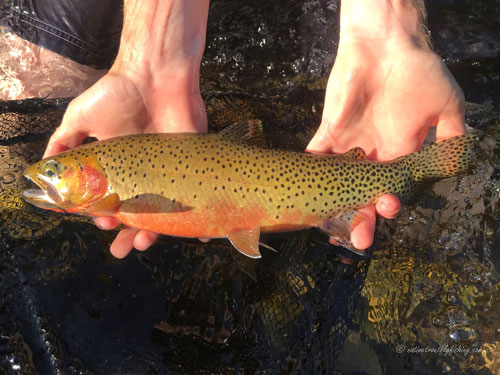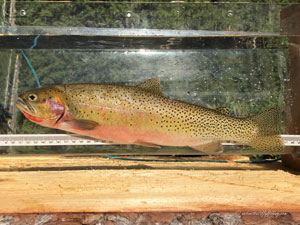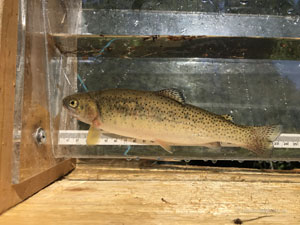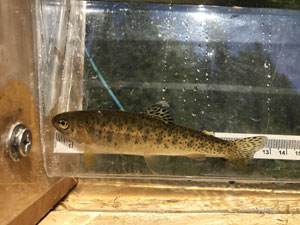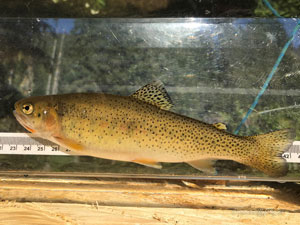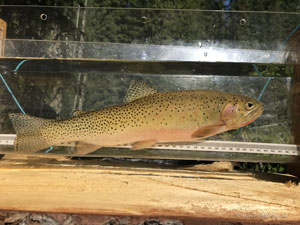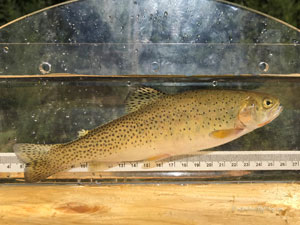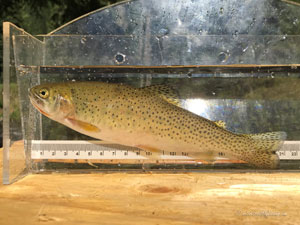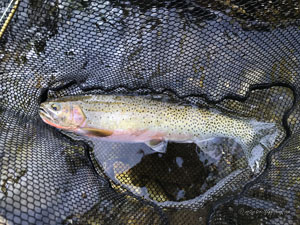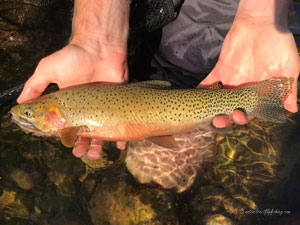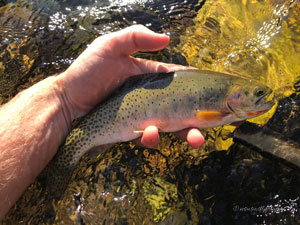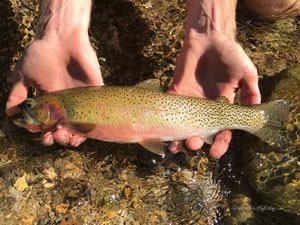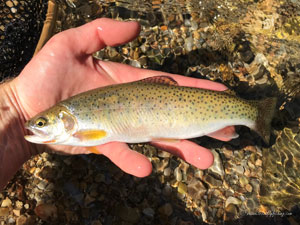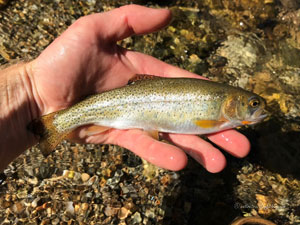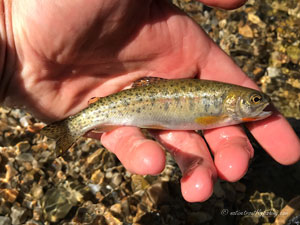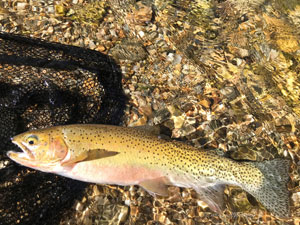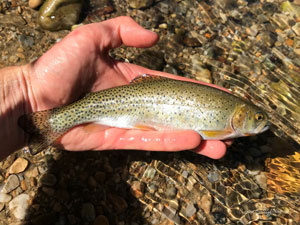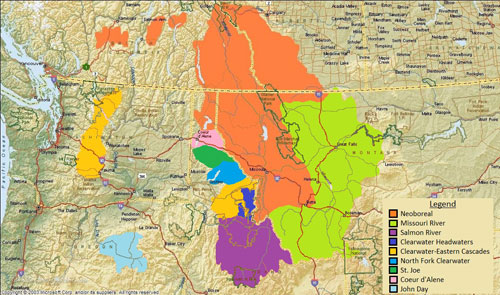North Fork Clearwater Westslope Cutthroat
Oncorhynchus lewisi ssp.
A fluvial North Fork Clearwater Westslope Cutthroat from an Idaho stream.
Introduction
The Clearwater drainage in Idaho represents a hot spot for Westslope Cutthroat diversity, with three unique genetic lineages, the Clearwater-Eastern Cascades Westslope Cutthroat, Clearwater Headwaters Westslope Cutthroat, and the North Fork Clearwater Westslope Cutthroat (Young et al. 2018). As their name implies, the North Fork Clearwater Westslope Cutthroat are native to the North Fork Clearwater River and its tributaries including Kelly Creek in Idaho and are genetically distinct enough to warrant subspecies status (Trotter et al. 2018).
Life History Information
The North Fork Clearwater Westslope Cutthroat exhibit stream resident, fluvial (river migrant) and adfluvial (lake migrant) life histories. It is thought that the stream resident form is predominantly found in tributary streams and headwater reaches of the North Fork Clearwater River. These stream resident fish typically reach a maximum size of 12” (30 cm) and are opportunistic feeders, preying on aquatic and terrestrial invertebrates (Behnke 2002). Fluvial fish are found in the mainstem North Fork Clearwater River and its larger tributaries, such as Kelly Creek and the Little North Fork Clearwater River. These fluvial fish typically rear in the lower reaches of tributary streams for their first 2-4 years of life (IDFG 2013). During spring juvenile fluvial Cutthroat move downstream out of the tributaries and into the mainstem North Fork Clearwater River or its major tributaries. Once in the mainstem the Cutthroat migrate up or downstream to find optimal habitat to maximize growth opportunities and generally reach a maximum size of around 18" (45 cm) (IDFG 2013), although some fish reach lengths of over 20”. During fall adult Cutthroat migrate downstream into the lower river or Dworshak Reservoir to overwinter with some fish documented traveling over 62 miles (100 km) (IDFG 2013). Overwintering Cutthroat often remain in these areas until they migrate upstream for spawning or water temperatures rise forcing them upstream. Spawning is thought to take place between late May and early June (Weigel et al. 2003). Since the construction of Dworshak Dam, it appears that a component of the Westslope Cutthroat in the watershed have adopted an adfluvial life history as subadult Cutthroat have been found utilizing the reservoir during the summer months.
Status
The North Fork Clearwater River Westslope Cutthroat Trout have been impacted by a variety of factors ranging from habitat destruction, hybridization, and overfishing. In 1996 Westslope Cutthroat including those in the North Fork Clearwater River were petitioned to be listed under the Endangered Species Act, but the listing was found to not be warranted (USFWS 1996, USFWS 2003). This was partially due to Westslope Cutthroat populations in Idaho being relatively healthy, primarily due to improved land protections and fisheries management practices since the 1970s.
While fisheries practices have improved today, historically Cutthroat populations in the North Fork Clearwater drainage were severely depleted due to overfishing. In response to declines in abundance and the size of the fish caught, in 1970 IDFG initiated its first catch and release Westslope Cutthroat fishery on Kelly Creek one of the larger tributaries to the North Fork Clearwater River (Mallet and Thurow 2021). Prior to the establishment of the catch and release fishery, there had been a 15 fish limit on Kelly Creek and sampled reaches typically only supported 5 Cutthroat with only 3.5% of those over 12” (30 cm) (Ball 1971). In just five years after catch and release regulations were adopted the abundance over Cutthroat in the sample reaches increased 13-fold, with Cutthroat over 12” (30 cm) increasing from 1 to 45 per sample reach (Johnson and Bjornn 1978). Since 2015 the abundance of Westslope Cutthroat in each sampling reach has fluctuated but overall has stabilized at approximately 15.59 per sample reach, showing the effectiveness of catch and release regulations at improving Westslope Cutthroat abundance (Mallet and Thurow 2021).
Much of the North Fork Clearwater watershed is managed by the United States Forest Service, with 70% of the federally managed land designated as roadless areas (IDFG 2013). This has provided habitat protection throughout large portions of the watershed. However, there are still parts of the basin that are intensively managed for timber harvest as well. The high density of roads in the areas managed for timber harvest, as well as logging practices pose risks to the Westslope Cutthroat due to a loss of riparian vegetation, increased sedimentation, which impedes egg survival and warmer stream temperatures. One of the most signification impacts to the North Fork Clearwater Westslope Cutthroat Trout was the construction of Dworshak Dam in 1974. The dam was constructed without any fish passage facilities and blocked migratory fish access to the watershed. The construction of the dam resulted in the loss of all salmon and Steelhead populations in the upper watershed and eliminated a significant forage supply for the Westslope Cutthroat. It is believed that North Fork Clearwater Westslope Cutthroat historically utilized the lower North Fork as well as the mainstem Clearwater River for overwintering and as such the dam also cut off an important migratory corridor for these fish. Additionally, the reservoir impounded 83 km (52 mi) of the North Fork Clearwater River, inundating much of the lower watershed eliminating historic rearing areas. Moffitt and Bjornn (1984) showed that following the construction of Dworshak Dam and the exclusion of anadromous species that the densities of trout (especially Redband Trout) decreased significantly in tributaries to the North Fork Clearwater River as the habitat was not being fully utilized by nonmigratory fish.
As with other Cutthroat Trout subspecies, nonnative trout have negatively impacted the North Fork Clearwater Westslope Cutthroat via hybridization, competition, and predation. Hatchery Rainbow Trout and Brook Trout were historically stocked throughout the North Fork Clearwater drainage, although stocking in the river and its tributaries was greatly reduced by 1975 and no stocking occurs in flowing waters of the basin today. Brook Trout, which are well known to outcompete native Cutthroat Trout were introduced into many tributaries of the North Fork Clearwater River and are believed have reduced the abundance and distribution of Cutthroat in many of the lower elevation streams in the basin (IDFG 2013). Rainbow Trout readily interbreed with Westslope Cutthroat and hybridization has been detected throughout much of the North Fork Clearwater drainage, especially at intermediate and lower elevations (Weigel et al. 2003). While it is believed that this hybridization is to be largely due to past stocking events, the level of genetic influence on the Cutthroat from native Redband Trout is unknown. Rainbow Trout are still stocked In Dworshak Reservoir annually, but since the year 2000 only sterile Rainbow Trout have been planted in the reservoir, limiting the potential impacts to competition and predation. In addition to Rainbow Trout, several other species such as Smallmouth Bass, Largemouth Bass, White Crappie and Kokanee (landlocked Sockeye Salmon) have been introduced to Dworshak Reservoir as well. Of these other species, Smallmouth Bass pose the greatest potential risk as they now are found 25 miles (40km) up the North Fork Clearwater River (IDFG 2013) and are well known predators on salmonids. On the other hand, it is likely that Kokanee provide a beneficial role in the watershed, filling part of the void left vacant by anadromous salmon. As Kokanee spawn in many of the tributaries throughout the basin, they provide food in for Cutthroat in the form of eggs, flesh and juveniles and their spawned-out carcasses provide added nutrients to the watershed increasing its overall productivity.
Despite legacy impacts on the North Fork Clearwater Westslope Cutthroat, the abundance of these trout is much greater than it was in the 1970s and appears to be stable (Hand 2021, Mallet and Thurow 2021). Today streams like Kelly Creek are known as some of the best Cutthroat fisheries that the west has to offer. Kelly Creek is known for supporting high catch rates for large abundant Westslope Cutthroat in a wilderness setting (Hunt and Bjornn 1991). Streams like Kelly Creek show that with improved management practices around both land use and fisheries it is possible to conserve Cutthroat populations while maintaining popular fisheries. With the abundance of Westslope Cutthroat in the North Fork Clearwater watershed at high and stable levels today, the future of these Cutthroat appears to be bright.
Description
The North Fork Clearwater River Westslope Cutthroat Trout are similar in appearance to other Westslope Cutthroat. The coloration on the backs of these fish is typically an olive, bronze or even grayish color. The sides fish range from a grayish color to tan or bronze and the bellies and gill plates typically show a peach to bright orange color and this same color may be found along the lateral line, often between the parr marks on smaller individuals. Spots are typically irregularly shaped, small to medium sized and concentrated towards the posterior region of the body and along the back with relatively few spots found below the lateral line in the middle of the body. Their fins typically are a yellow to orange or peachy color and spots are typically found on the dorsal, adipose and caudal fins.
Fluvial Form
Click on images to view a larger picture
Native Range
Above: A map of the native range of the Westslope Cutthroat trout. Data Sources: Behnke (2002), Trotter (2008) and Young et al. (2018). Below: A map of the native range of the North Fork Clearwater Westslope Cutthroat Trout.
References
Ball, K. 1971. Evaluation of catch-and-release regulations on Cutthroat Trout in the North Fork of the Clearwater River. Job No. 1. Catch and regulations (evaluation of) in management of Cutthroat Trout. Annual Completion Report F-59-R-2. Idaho Fish and Game Department, Moscow, Idaho.
Behnke, R. 2002. Trout and Salmon of North America. Chanticleer Press, New York.
Hand, R., S. Wilson, D. Hannasch, J. Renner and J. DuPont. 2021. Idaho Department of Fish and Game fishery management annual report: Clearwater region 2017. Idaho Department of Fish and Game, IDFG 21-107, Final Report, Boise, Idaho.
Hunt, J.P. and T.C. Bjornn. 1991. Re-evaluation of the status of fish populations in Kelly Creek, the North Fork of the Clearwater, St. Joe and Lochsa River drainages in 1989. Job Progress Report Project F-71-R-13. Subproject III, Job No. 11. Idaho Cooperative Fish and Wildlife Research Unit. University of Idaho, Moscow, Idaho.
IDFG. 2013. Management plan for the conservation of Westslope Cutthroat Trout in Idaho. Idaho Department of Fish and Game. Fisheries Bureau, Boise, Idaho.
Johnson, T.H. and T.C. Bjornn. 1978. Evaluation of angling regulations in management of cutthroat trout. Project F-59-R-7. Idaho Cooperative Fish and Wildlife Research Unit. University of Idaho, Moscow, Idaho.
Mallet, J. 2013. Saving Idaho's Westslope Cutthroat Trout fisheries. IDFG Report Number 13-14. Idaho Department of Fish and Game, Boise, Idaho.
Moffitt, C.M. and T.C. Bjornn. 1984. Fish abundance upstream from Dworshak Dam following the exclusion of Steelhead Trout. Technical Completion Report. Idaho Water and Energy Resources Research Institute. University of Idaho. Moscow, Idaho.
Weigel, D.E., J.T. Peterson and P. Spruell. 2003. Introgressive hybridization between native cutthroat trout and introduced rainbow trout. Ecological Applications 13(1): 38-50.
Trotter, P., P. Bisson, B. Roper, L. Schultz, C. Ferraris, G.R. Smith and R.F. Stearley. 2018. A special workshop on the taxonomy and evolutionary biology of cutthroat trout. Pages 1-31 in Trotter P, Bisson P, Schultz L, Roper B (editors). Cutthroat Trout: Evolutionary Biology and Taxonomy. Special Publication 36, American Fisheries Society, Bethesda, Maryland.
USFWS. 1996. Endangered and threatened wildlife and plants; notice of final decision on identification of candidates for listing as endangered or threatened. FR 61:65581-64485.
USFWS. 2003. Endangered and threatened wildlife and plants: reconsidered finding for an amended petition to list the Westslope Cutthroat Trout as threatened throughout its range. FR 68:46989-47009.
Young, M.K., K.S. McKelvey, T. Jennings, K. Carter, R. Cronn, E.R. Keeley, J.L. Loxterman, K.L. Pilgrim and M.K. Schwartz. 2018. The phylogeography of Westslope Cutthroat Trout. Pages 261-301 in Trotter P, Bisson P, Schultz L, Roper B (editors). Cutthroat Trout: Evolutionary Biology and Taxonomy. Special Publication 36, American Fisheries Society, Bethesda, Maryland.
Contact
Feel free to contact me if you have any questions or comments
North Fork Clearwater Westslope Cutthroat Trout Links
My North Fork Clearwater Westslope Cutthroat Trips
Idaho Department Fish and Game - Westslope Cutthroat Trout
Nez Perce-Clearwater National Forest
Western Native Trout Initiative - Westslope Cutthroat Trout
Native Trout Links
Truchas Mexicanas' - Native Trout of Mexico
Balkan Trout Restoration Group
Trout and Seasons of the Mountain Village - About Japanese Trout
Western Native Trout Challenge
California Heritage Trout Challenge
Fly Fishing Blogs
Dave B's Blog: Fly Fishing for Native Trout
The Search for Native Salmonids
Conservation Links
Western Native Trout Initiative
Fly Fishing Links
Fishing Art Links
Americanfishes.com - Joseph R. Tomelleri
